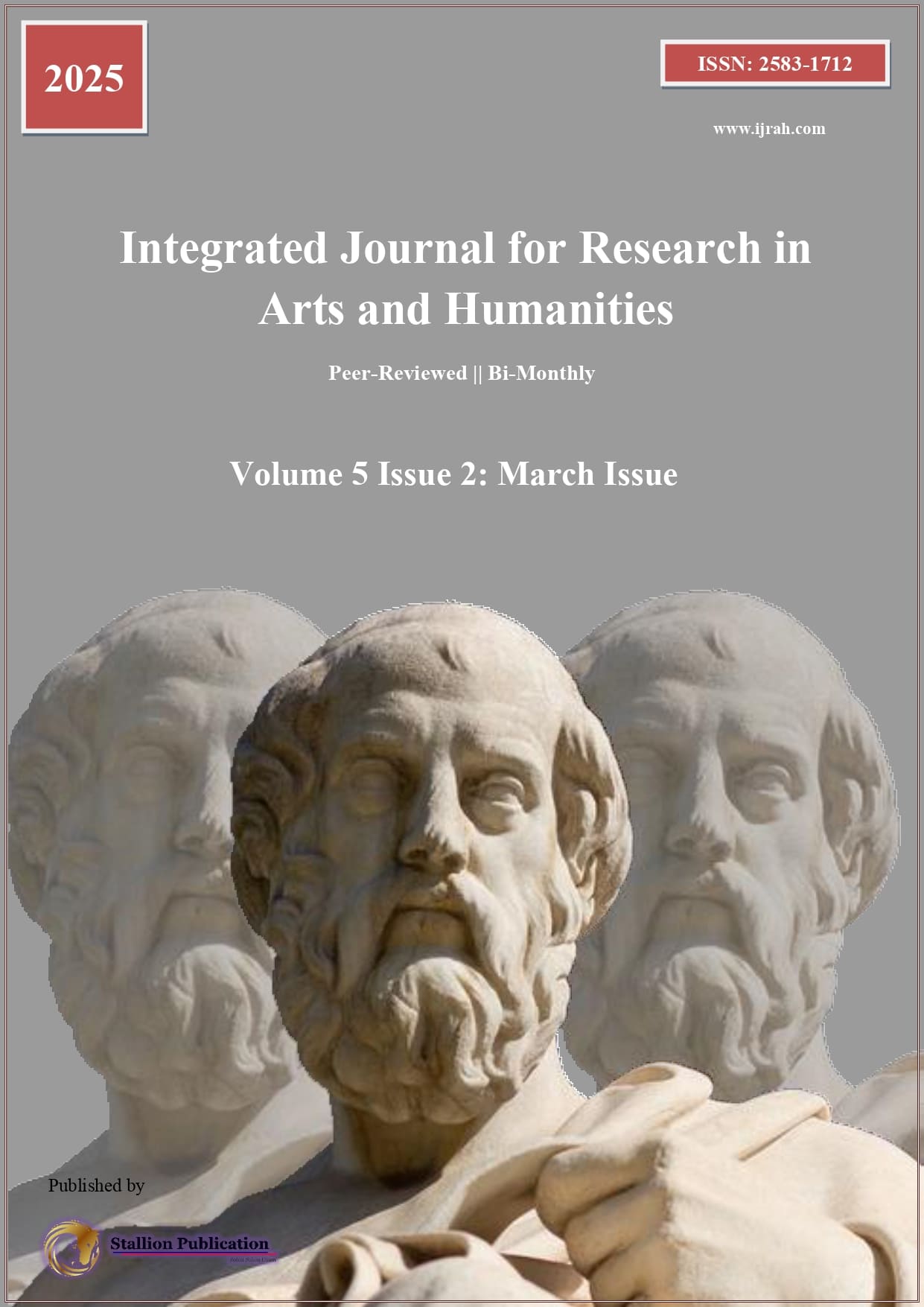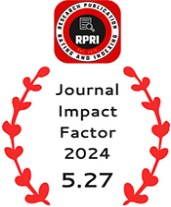Dimensions in Tertiary EFL Learners’ Syntactical Acquisition: Focus on Clausal Constructions
DOI:
https://doi.org/10.55544/ijrah.5.2.28Keywords:
EFL Writing, Error Analysis, Syntactic Errors, Acquisition of Clause Construction, Tertiary EFL EducationAbstract
Linguistic performance, supported by socio-cognitive competencies, is a crucial aspect in EFL (English as a Foreign Language) writing. The study investigates the acquisition of English clause constructions among tertiary English as a foreign language (EFL) students. The research focuses on syntactical content, as it is crucial for primary communication in writing. However, there is a lack of research in this area, particularly regarding common clause construction errors. A corpus of 105 narrative essays from 105 tertiary English and non-English major students (75 females, 30 males) of Bangladeshi private and public universities was used as the qualitative content data. The data was analyzed using Hsieh and Shannon's summative content analysis method (2005) to identify acquisition challenges and pedagogical needs. Findings indicate that tertiary EFL students exhibit some ease in acquiring coordinate clauses, while they display a protracted struggle with the acquisition of subordinate clauses and subject-verb agreement. It further indicates that Bangladeshi tertiary EFL students’ syntactic mastery across diverse clause subtypes and aspects is not only non-linear but also asymmetrical. Based on the findings, the study suggests reshaping syntax pedagogy to emphasize syntactic subordination and subject-verb agreement, adapting scaffolding to clause complexities, shifting traditional paradigms towards dynamic, engaging practice, and incorporating socio-cognitive schema.
Downloads
References
Abied, A., Ali, A., & Ashfello, M. (2023). Error Analysis of the Written English Essays by Libyan EFL Learners: Case study of Alasmarya University EFL students. Journal of Humanitarian and Applied Sciences, 7(13), 425–442. Retrieved from https://khsj.elmergib.edu.ly/index.php/jhas/article/view/249
Aidinlou, N. A., & Pandian, A. A. (2011). The Impact of Local and Global Conjunctions on ESL Reading Comprehension: A Systemic Perspective. Journal of Language Teaching and Research, 2(2). https://doi.org/10.4304/jltr.2.2.387-395
Alam, M.S. & Asmawi, A. (2023). Understanding identity salience and English as a Foreign Language teaching practices: A case study of multi‐subject generalist teachers. Review of Education, 11(3). https://doi.org/10.1002/rev3.3424
Ali, M. M., Hamid, M. O., & Hardy, I. (2018). Ritualisation of Testing: Problematising High-stakes English Language Testing in Bangladesh. Compare: A Journal of Comparative and International Education, 50(04), 533–553. https://doi.org/10.1080/03057925.2018.1535890.
Asadi, N., Oskuee, M. Y., & Salehpour, S. (2012). Investigating the Use of Paratactic and Hypotactic Conjunctions among Iranian Pre-university Students. Journal of English Language Pedagogy and Practice, 10(11), 158-170. https://journals.iau.ir/article_519842.html
Bennui, P. (2008). A Study of L1 Interference in the Writing of Thai EFL Students. Malaysian Journal of ELT Research, 4 (2), 72–102. https://www.melta.org.my/journals/MAJER/downloads/majer04_01_06.pdf
Benzigar, M. (2013). The Rural Madurai Undergraduates’ English Writings: An analysis. Research Journal of English Language and Literature, 1 (4), 102–107. https://efaidnbmnnnibpcajpcglclefindmkaj/http://www.rjelal.com/Vol1.Issue%204/Benz%20102-107.pdf
Berry, R. (2012). English Grammar: A Resource Book for Students. London: Routledge.
Bickman, L., & Rog, D. J. (2009). The SAGE handbook of applied social research methods. Los Angeles Sage.
Bipasha, S. R. (2025). Instruction of Vocabulary at the Higher Secondary Level in Bangladesh: Integration of Communicative Language Teaching (CLT) with Vocabulary Tasks. International Journal of Social Science and Education Research Studies, 05(02). https://doi.org/10.55677/ijssers/v05i02y2025-02
Brown, H.D. (1994). Teaching by principles: Interactive language teaching methodology. New York: Prentice Hall Regents.
Brown, H.D. (2014). Principles of Language Learning and Teaching (6th ed). Upper Saddle River: Pearson.
Brown, G. T. L., Glasswell, K., & Harland, D. (2004). Accuracy in the scoring of writing: Studies of reliability and validity using a New Zealand writing assessment system. Assessing Writing, 9 (2), 105–121. https://doi.org/10.1016/j.asw.2004.07.001
Chomsky, N. (1965). Aspects of the theory of syntax. Cambridge, Massachusetts: The MIT Press.
Corder, S. P. (1973). Introducing applied linguistics. Harmondsworth: Penguin.
Corder, S. P. (1967). The significance of learner's errors. International Review of Applied Linguistics, 5 (4), 161-170. https://doi.org/10.1515/iral.1967.5.1-4.161
Connor, U. (2003). Contrastive rhetoric: cross-cultural aspects of second-language writing. Cambridge University Press.
Dulay, H., Burt, M., and Krashen, S. (1982). Language two. Oxford. Oxford University Press.
Ellis, R. (1997). The study of second language acquisition. Oxford: Oxford University Press.
Erdogan, V. (2005). Contribution of error analysis to foreign language teaching. Mersin University Journal of the Faculty of Education, 1(2), pp. 261-270. https// doi.org/10.17860/efd.22900
Graneheim, U. H., & Lundman, B. (2004). Qualitative content analysis in nursing research: concepts, procedures and measures to achieve trustworthiness. Nurse Education Today, 24(2), 105–112. https://doi.org/10.1016/j.nedt.2003.10.001
Google. (n.d.). Clause constructions. Retrieved March 30, 2025, from https://www.google.com/search?q=clause+constructions
Hacker, D., & Sommers, N. (2011). A Writer’s Reference (7th ed.). Bedford: St. Martin’s
Halliday, M.A.K., & Hassan, R. (1976). Cohesion in English. London: Longman Group
Halliday, M. A. K., & Matthiessen, C. M. I. M. (2004). An introduction to functional grammar (3rd ed.). London: Edward Arnold.
Hamid, M. O., & Baldauf, R. B. (2014). Public-private domain distinction as an aspect of LPP frameworks: A case study of Bangladesh. Language Problems and Language Planning, 38(2), 192–210. https://doi.org/10.1075/lplp.38.2.05h am.
Hamid, M. O., & Erling, E. J. (2016). English-in-Education Policy and Planning in Bangladesh: A Critical Examination. Language Policy, 11, 25–48. https://doi.org/10.1007/978-3-319-22464-0_2
Harmer, J. (2004). How to teach writing. Essex, UK: Longman.
Hornby, A.S., Deuter, M., Turnbull, J., Bradbery, J., Hey, L., Holloway, S., & Oxford University Press. (2015). Oxford Advanced Learner’s Dictionary of Current English. Oxford University Press.
Hossain, M. S. & Ashikullah, M. (2023). Error Analysis of Students’ Free Writing: A Case Study of Bangladeshi Tertiary Level EFL Learners with a Bengali Medium Background. Journal of English Studies (JES), 1(1) 77-96. https://www.isu.ac.bd/assets/backend/pdf/journal/20240625060039.1%20(7).pdf
Hossain, M. K. (2024). Error analysis of English essays of Bangladeshi undergraduate learners. Journal of Applied Linguistics and Language Research, 11(4), 72-90. https://www.researchgate.net/publication/385797218_Error_Analysis_of_English_Essays_of_Bangladeshi_Undergraduate_Learners
Hsieh, H. F., & Shannon, S. E. (2005). Three Approaches to qualitative content analysis. Qualitative Health Research, 15(9), 1277-1288. https://doi.org/10.1177/1049732305276687
Husna, L. (2017). An Analysis of Students’ Writing Skill in Descriptive Text at Grade X1 IPA 1 of MAN 2 Padang. Jurnal Ilmiah Pendidikan Scholastic, 1(1), 16-28. https://doi.org/10.36057/jips.v1i1.281
Hyland, K. (2009). Teaching and researching writing. (2nd ed.). Harlow: Longman Pearson
Kemassi, S. and Boulifa, Y. (2019). The Effect of Interlingual Interference on the Use of Clausal Coordination and Subordination in EFL Writing: The Case of Third Year ‘Licence’ EFL Students at Kasdi Merbah University -Ouargla-.Univ-ouargla.dz. [online] http://dspace.univ-ouargla.dz/jspui/handle/123456789/23447.
Islam, M. N., & Hashim, A. (2019). Historical Evolution of English in Bangladesh. Journal of Language Teaching and Research, 10(2), 247–255. https://doi.org/10.17507/jltr.1002.05
Khansir, A. A. (2013). Error Analysis and Second Language Writing. Theory and Practice in Language Studies, 3(2), 363-370. http://doi:10.4304/tpls.3.2.363-370
Kitamura, F. C. (2023). ChatGPT is shaping the future of medical writing but still requires human judgment. Radiology, 307(2), e230171. https://doi.org/10.1148/radiol.230171
Klimova, B. F. (2014). Constraints and Difficulties in the Process of Writing Acquisition. Procedia-Social and Behavioral Sciences, 122, 433-437. https://doi.org/10.1016/j.sbspro.2014.01.1367
Lado, R. (1957). Linguistics across cultures. Ann Arbor: University of Michigan Press.
Langan, J. (2008). College writing skills with readings. New York, NY: McGraw-Hill Education.
Liu, L. (2018). Examining syntactic complexity in EFL academic writing. Polyu.edu.hk. [online] https://doi.org/991022109838503411.
Merriam-Webster. (2014). Merriam-Webster’s dictionary and thesaurus. Turtleback Books.
Murphy, R. (2019). English grammar in use: a self-study reference and practice book for intermediate learners of English: with answers. Cambridge: Cambridge University Press.
McGraw, N.L. & Tondy, N. (2015). Summer solutions common core English grammar and mechanics, Level 8. Beachwood, Ohio: Simple Solutions.
Morris L. (1996). Interaction in the language classroom: Awareness, Autonomy and Authenticity. Harlow: Longman.
Mousumi, M. A., & Kusakabe, T. (2017). The Dynamics of Supply and Demand Chain of English-Medium Schools in Bangladesh. Globalisation, Societies and Education, 15(5), 679–693. https://doi.org/10.1080/14767724.20 16.1223537.
Munro, J. (2010). Common Faults in English Syntax and Grammar. Centre for Medieval Studies, University of Toronto. http://www.economics.utoronto.ca/munro5/. Retrieved 10 April, 2020, from https://www.economics.utoronto.ca/munro5/syntax.htm
Myles, J. (2002). Second Language Writing and Research: The Writing Process and Error Analysis in Student Texts. Tesl-Ej, 6(2), 1-20. http://tesl-ej.org/wordpress/issues/volume6/ej22/ej22a1/?wscr
Negari, G. M. (2011). A Study on Strategy Instruction and EFL Learners' Writing Skill. International journal of English linguistics, 1(2), 299-307. http://doi:10.5539/ijel.v1n2p299
Nordquist, R. (2020). English as a Lingua Franca (ELF). Retrieved 14 April, 2020, from https://www.thoughtco.com/english-as-a-lingua-franca-elf-1690578
Ortega, L. (2015). Syntactic Complexity in L2 Writing: Progress and Expansion. Journal of Second Language Writing, 29, 82-94. doi: https://doi.org/10.1016/j.jslw.2015.06.008
Oshima, A. & Houge, A. (1991). Writing Academic English: A Writing and Sentence Structure Handbook (2nd edition). Cambridge: Addison-Wesley Publishing Company.
Patwary, M. N., Alam, M. S., & Reza, M. M. (2023). Exploring Nuanced Errors in Bangladeshi Tertiary EFL Students’ Writing Mechanics: A Pedagogical Implication. Bulletin of Advanced English Studies, 8(2), 93–102. https://doi.org/10.31559/baes2023.8.2.5
Patwary, M. N. & Reza, M. M. (2024). A Nuanced Understanding of Bangladeshi Tertiary EFL Writing Course Syllabi: Pedagogical Implications. The International Journal of Pedagogy and Curriculum, 32(1), 15–35. https://doi.org/10.18848/2327-7963/cgp/v32i01/15-35
Patwary, M.N., Md. Reza, M.M, Akter, H., & Chowdhury, S. (2023). Exploring Academic Writing Proficiency of Tertiary EFL Learners of Bangladesh: A Pedagogical Implication. Integrated Journal for Research in Arts and Humanities, 3(5), 89–102. https://doi.org/10.55544/ijrah.3.5.8 https://doi.org/10.18848/2327-7963/cgp/v32i01/15-35
Pongwatcharapakron, S. (2014). An analysis of sentence errors in writings of mattayom 5 students at Horwang school (An independent study of Master of Arts). Thammasart University, Bangkok, Thailand. Retrieved 10 April, 2020, from http://digital.library. tu.ac.th/tudc/frontend/Info/item/dc:104172 https://doi.org/10.18848/2327-7963/cgp/v32i01/15-35
Pornthanachotanan, M. (2020). An Analysis of Thai Students’ Errors on English Fragments, Run-Ons, and Comma Splices: A Comparison between Science-Math and Intensive Science-Math Programs. [online] Available at: https://ethesisarchive.library.tu.ac.th/thesis/2020/TU_2020_6221040253_14227_13989.pdf [Accessed 23 Sep. 2024].
Quader, D. A. (2001). Reaction to innovation in a language teaching project. Journal of the Institute of Modern Languages, 5, 22.
Qin, C. L. (2017). An Analysis of Native Language Transfer in English Writing for Non-English Major Students. Studies in Literature and Language, 15 (5), 27-43. Available from: http://www.cscanada.net/index.php/sll/article/view/10079 . http://dx.doi.org/10.3968/10079
Rahman, M. M., & Pandian, A. (2018a). A critical investigation of English language teaching in Bangladesh: Unfulfilled expectations after two decades of communicative language teaching. English Today, 34(3), 43–49. https://doi.org/10.1017/S026607841 700061X.
Rahman, M. M., & Pandian, A. (2018b). Social Sciences & Humanities the Chaotic English Language Policy and Planning in Bangladesh: Areas of Apprehension. Pertanika Journal of Social Sciences & Humanities, 26(2), 893–908.
Raimes, A. (1983). Techniques in Teaching Writing. Oxford University Press, 200 Madison Ave., New York, NY 10016 (ISBN-0-19-434131-3, $5.95). https://eric.ed.gov/?id=ED242212
Randolph, J. (2009). A guide to Writing the Dissertation Literature Review. Practical Assessment, Research, and Evaluation, 14(1), 13. https://doi.org/10.7275/b0az-8t74
Richards, J. (1970). A Non-Contrastive Approach to Error Analysis. Paper Presented at TESOL Convention, San Francisco, May, 1970.
Sattayatham, A., & Ratanapinyowong, P. (2008). Analysis of errors in paragraph writing in English by first year medical students from the four medical schools at Mahidol University. Silpakorn University International Journal, 8, pp.17–38. https://thaiscience.info/Journals/Article/SUIJ/10499015.pdf.
Schaaf, M., Boydell, V., Topp, S. M., Iyer, A., Sen, G., & Askew, I. (2022). A Summative Content Analysis of How Programmes to Improve the Right to Sexual and Reproductive Health Address Power. BMJ Global Health, 7(4), e008438. http://dx.doi.org/10.1136/bmjgh-2022-008438
Sermsook, K., Liamnimitr, J. & Pochakorn, R. (2017). An Analysis of Errors in Written English Sentences: A Case Study of Thai EFL Students. English Language Teaching, 10(3), 101-110. https://doi.org/10.5539/elt.v10n3p101.
Shirban S. A., & Lai, J. C. M. (2021). Error Analysis of Taiwanese University Students’ English Essay Writing: A Longitudinal Corpus Study. International Journal of Research in English Education, 6(4), 57–74. https://doi.org/10.52547/ijree.6.4.57
Solikhah, I. (2017). Linguistic Problems in English Essay by EFL Students. IJOLTL: Indonesian Journal of Language Teaching and Linguistics, 2(1), 31. https://doi.org/10.30957/ijoltl.v2i1.231
Street, C. T., & Ward, K. W. (2012). Improving Validity and Reliability in Longitudinal Case Study Timelines. European Journal of Information Systems, 21(2), 160–175. https://doi.org/10.1057/ejis.2011.53
Sawalmeh, M. (2013). Error Analysis of Written English Essays: The Case of Students of the Preparatory Year Program in Saudi Arabia. English for Specific Purposes World, 14 (40), 1-16, ISSN 1682-3257, http://www.esp-world.info.
Sultan, S. (2015). Syntactic Errors in Pakistani Undergraduate Students’ Written English. Journal of Education and Social Sciences, 3(2), 245-259. https://geistscience.com/JESS/issue2- 15/Article3/JESS1502103.pdf
Sultana, S. (2019). “Approaches to Academic Writing at the Tertiary Level in Bangladesh.” PhD thesis, University of Goa.
Teng, M. F., Wang, C., & Zhang, L. J. (2022). Assessing Self-Regulatory Writing Strategies and Their Predictive Effects on Young EFL Learners’ Writing Performance. Assessing Writing, 51, 100573. https://doi.org/10.1016/j.asw.2021.100573
Thi, N. K., & Nikolov, M. (2022). How Teacher and Grammarly Feedback Complement One Another in Myanmar EFL Students’ Writing. The Asia-Pacific Education Researcher, 31(6), 767-779. https://doi.org/10.1007/s40299-021-00625-2
Tse, A. Y. H. (2014). A Case Study of Grammatical Errors Made by Malaysian Students. International Journal of Science Commerce and Humanities, 2 (5), 154-160. https://www.academia.edu/27322624/A_Case_Study_of_Grammatical_Errors_Made_by_Malaysian_Students
Urdaneta, J.L.L. (2011). Spanish-English Writing Structure Interferences in Second Language Learners. GiST Education and Learning Research Journal, 5, 158–179. chrome-extension://efaidnbmnnnibpcajpcglclefindmkaj/https://files.eric.ed.gov/fulltext/EJ1062595.pdf
Warschauer, M. (2007). Technology and Writing. In: Cummins, J., Davison, C. (eds) International Handbook of English Language Teaching. Springer International Handbooks of Education, 15, 907-917, Springer, Boston, MA. https://doi.org/10.1007/978-0-387-46301-8_
Watcharapunyawong, S., & Usaha, S. (2012). Thai EFL students’ writing errors in different text types: The interference of the first language. English Language Teaching, 6 (1), 67.
Wu, H. P., & Garza, E. V. (2014). Types and Attributes of English Writing Errors in the EFL Context-A Study of Error Analysis. Journal of Language Teaching and Research, 5(6), 1256-1262. http://doi:10.4304/jltr.5.6.1256-1262
Downloads
Published
How to Cite
Issue
Section
License
Copyright (c) 2025 Md. Nurullah Patwary, Mohoshin Reza, Sadia Afroj Tithi, Humayra Akter

This work is licensed under a Creative Commons Attribution-NonCommercial-NoDerivatives 4.0 International License.




















